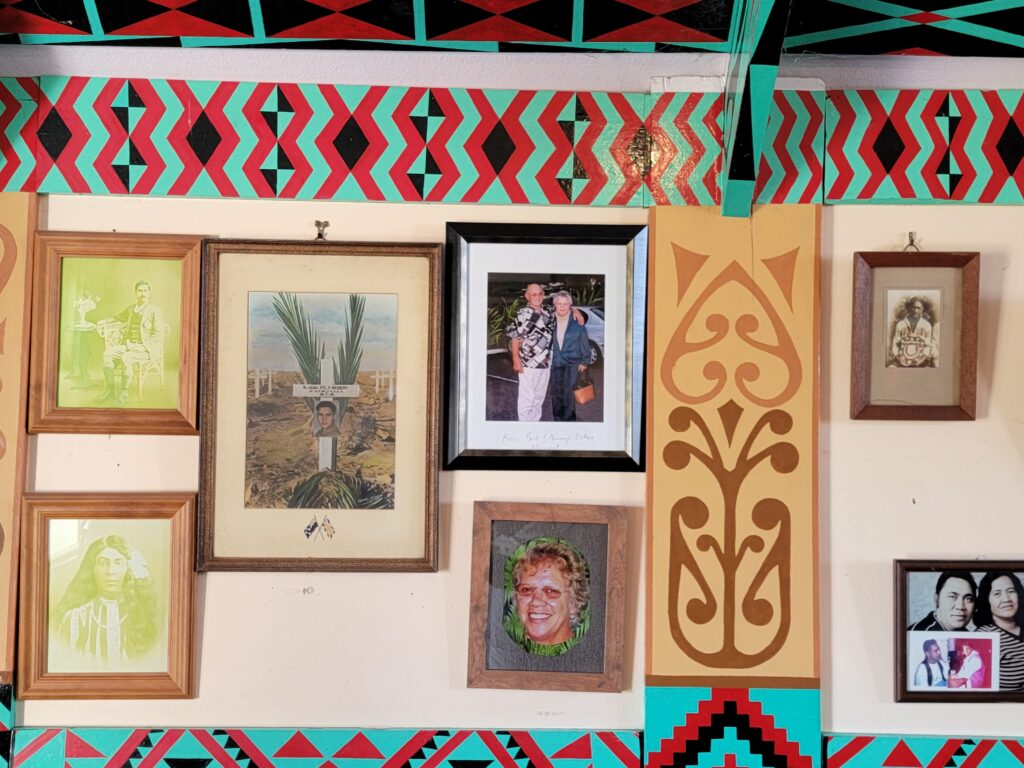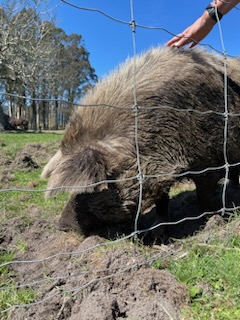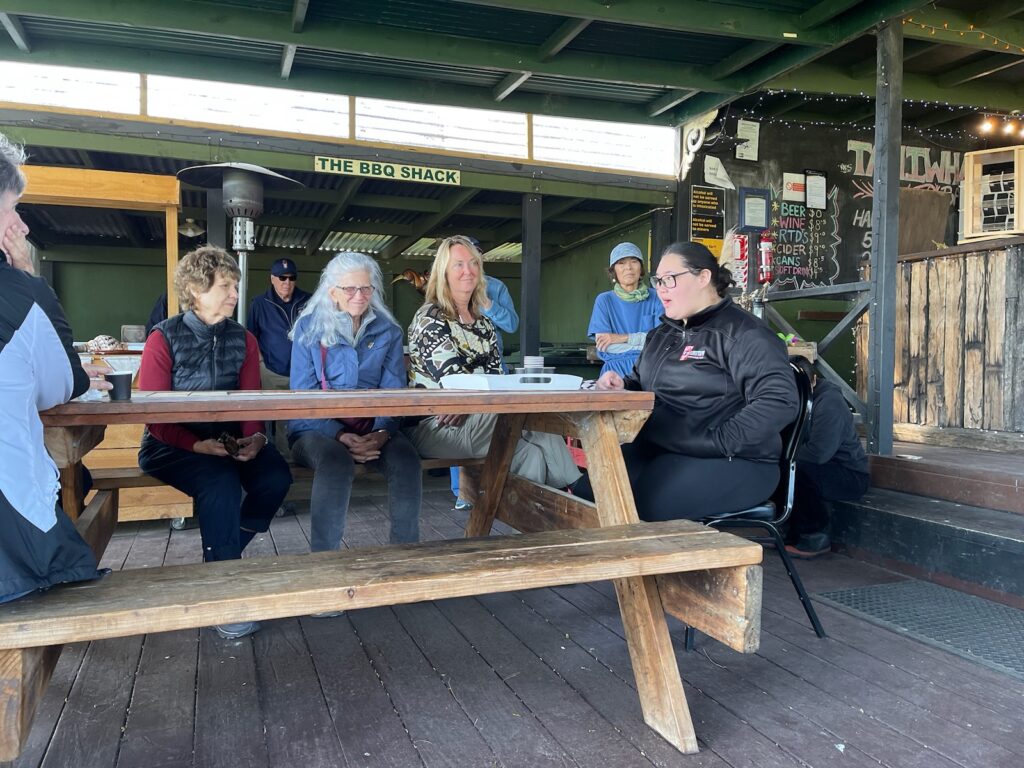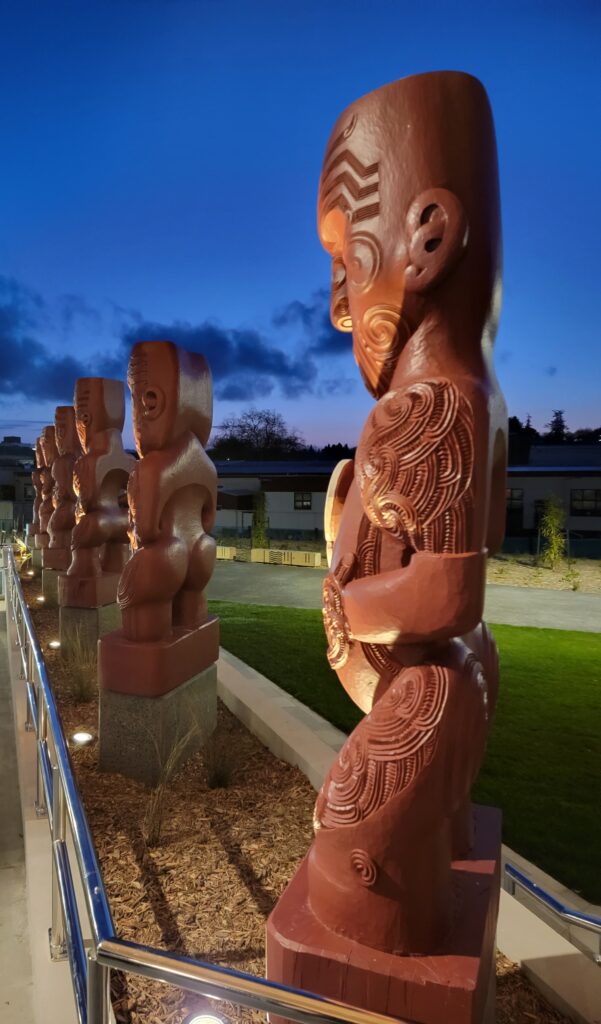
Today was a day in the life of the Ngāti Manawa people. We got out from the hotel early and headed by bus to learn about all aspects of life of the Ngāti Manawa Māori.
We had a very energetic young gal as our guide. She started out by giving us her “pepeha.” A “pepeha” is a way of introducing yourself in Māori. It tells people who you are by sharing your connections with the people and places that are important to you.
By the way, if I haven’t said this already, Māori is pronounced “MAH-rri” (flicked or lightly rolled R), not “may-OH-ri.” I’ve said it wrong all my life and am really trying to get it right.
And back to our regularly scheduled program…
In essence, the pepeha is an introduction of a person and their affiliations in a Māori context for one purpose, to make connections. Most people mistakenly think that the pepeha is all about introducing yourself – it’s not. It’s a way to find common ground – our guide called it a “verbal passport.”
Generally, the “template” goes from the mountain your “people” identify with, then river, then ancestry (your boat from Tahiti), your community, your Whānau (pron: Faaah-noh) or family, then your given name.
Our O.A.T. group is referred to when we meet Māori as that word – “whānau.” Dave (“Rawe” in Māori) is the oldest of us and therefore our Rangatira (“Chief”). When we are meeting Māori, he not only introduces his “whānau,” but also invites the Māori we are meeting to become part of it. It’s quite like Hawaiian family ties. Families are usually large, encompassing all extended family through in-laws and blood ties because kinship is a vital part of Māori culture. There are lots of “Aunties” and “Uncles.”
In case you’re interested, HERE is a bunch of Māori words that we have learned and are actually using, along with kōpaki, which means “folder” – as in the folder that has our itinerary for the day. And if you’re curious, “Sandy” is “Kirikiri” in Māori – but that means “sandy” as in “beach.” That’s okay – I like it.
Our keen young guide used Ka pai (“KAH-pie”) a lot, which means basically “All good?” To which you respond Ka pai! (All good!) She also said “you’se” a lot, which I know was annoying to a number of folks in our group but come to find out that – like “Ya’ll” in the American South – that actually is how native New Zealanders say “you, plural”! Our Guide Rod, being transplanted British, does not use this phraseology, but after being exposed to it with the guide, I’m hearing it constantly.
The town where we had our outing is called Murapara. Our guide explained that there are not as many Māori in the South Island as the North, because “The South Island was covered with ice when we came, and we are tropical people.” Back 100 years ago, this town was the richest in New Zealand because of the timber industry. Of course – you guessed it – the government quite recently (believe she said 1930 but I might be mistaken) took the land away and their job prospects plummeted, which led to a lot of violence, suicide, gangs, etc. The government then sold the land, of which a huge part was purchased by Harvard University. (Surprised?) So basically, the people that owned it now are working (when there’s work) to make money for Harvard.
Some of this is changing, and in some parts, the Māori now own the land . . . but Harvard and the like own all the forests on top of the land.
We learned that 20% of the curriculum needs to be Māori-oriented in schools, including myths, legends, and land history. As we had heard from Dane back in Auckland, there are even kindergartens that only speak Māori – but the problem is whether the parents can help the kids (i.e., how can they help with the homework if they don’t speak the language?)
We drove through the town, which is quite obviously very poor. It was so sad to see, especially after hearing that it had once been the wealthiest town in all of New Zealand. We headed then to Tipapa Marae, where we had a special Māori ceremony to welcome us. It involved “bringing in and welcoming to the Marae” not only the living (us), but also the dead/ancestors.
The two welcoming priestesses sang to us, and in a call and response with the elder (woman) who was leading us, we walked slowly up to the Marae. Women went first, men after. Then, we took seats with the men in front (protecting us), women in back. A male elder did a very long presentation story in Māori. Is it bad to say that – as I had gotten up at 2:00 a.m. – I was definitely trying to hold my head up during this part?
Our “Rangatira” David “introduced us” to the priestesses and the male elder leader who had told the story, and then we sang our song to them. Luckily, Cindy had the words with her, and I remembered the tune. Rod was a bit flustered trying to find it on his phone, but with the words, I was able to lead. We did really well. It’s fun to see the reaction in the gathered Māori, especially as we can hold a tune and sing pretty loud!
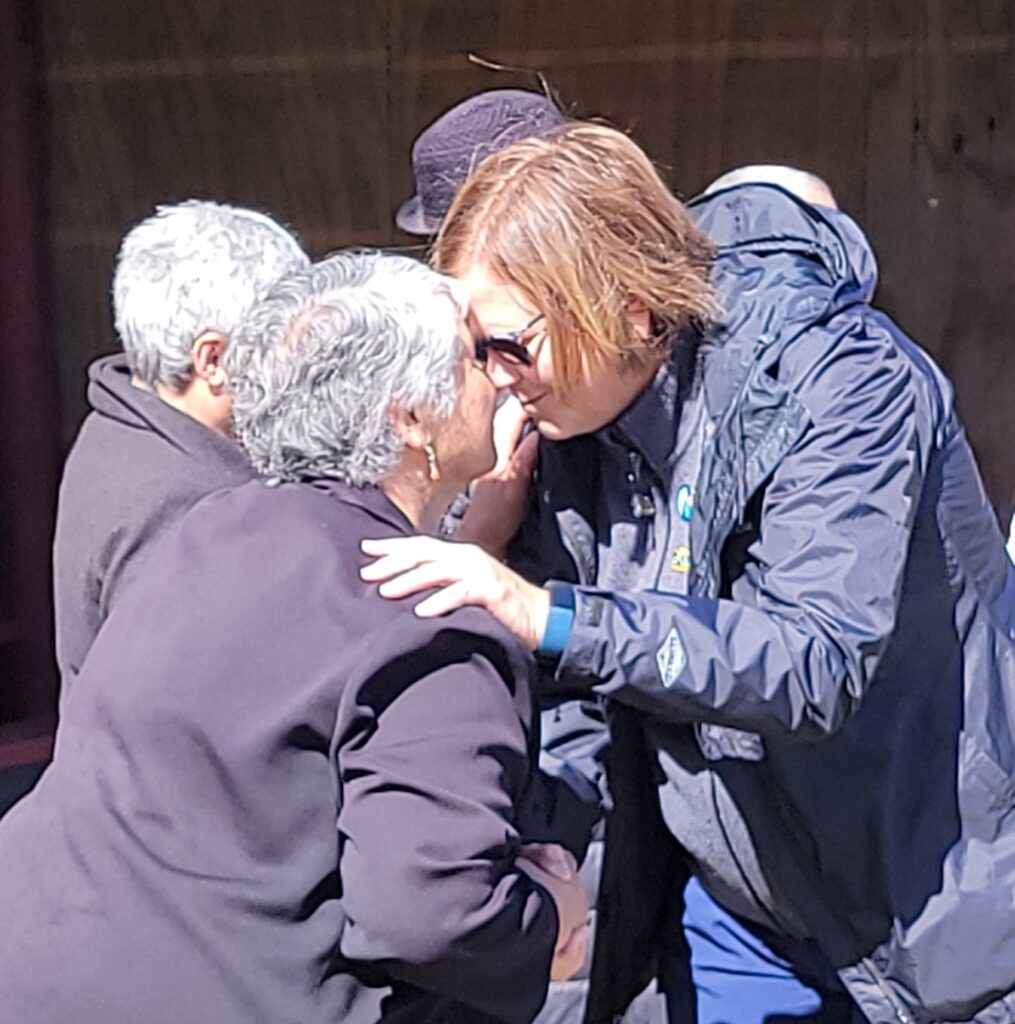

Then, after tea and cookies, we were welcomed by traditional hangi (pressing of noses). I took a few pictures of our group after I got through the line (men went first). We were told that the hangi is the way of greeting because “God breathed life into Adam this way – he didn’t shake his hand.” 😊 (The male elder was born-again Christian; there was a lot of Jesus, Jesus, Jesus, if you’re not born again you’re going to Hell with this guy, which was surprising and not my favorite . . . Oh oops, going to Hell again . . . )
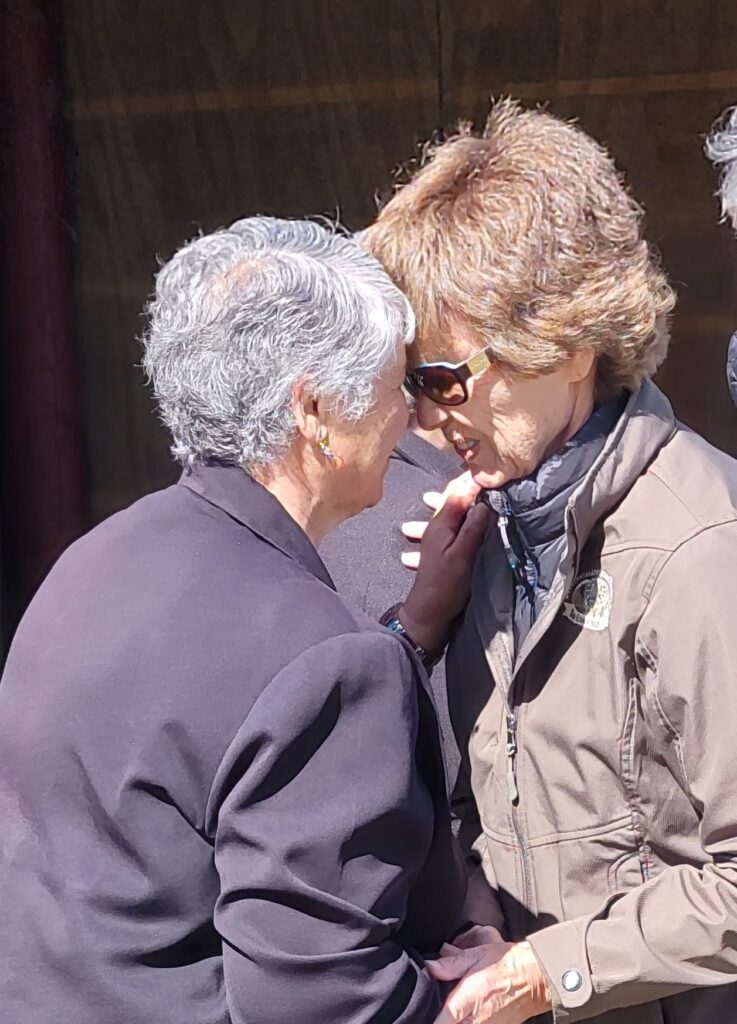

I did like the story he told of how The People started in Egypt, then came through Israel, then “got into canoes like Noah’s big canoe” to come to Polynesia. 😊 He also told us that when different Māori Iwi (tribes) would meet, an olive branch would be cast down between them, and if the visitor took it by grabbing it with his hand over the top (i.e., palm down), that would signify War, but if he grabbed it with his hand underneath (i.e., palm up, branch in the palm), Peace. He told us a bit more of the story of how their Iwi originally harvested the forest with axes, then his uncle was one of the first to be given a chain saw – which he took out to immediately take a “whack” at the trunk of a tree as if it were an axe!
Unfortunately, the technology went from axes to chain saws to mechanized machines. These can take down the trees at an amazingly fast pace. I’m not 100% sure, but my memory is that a gang of men could take down 100 trees in a day, but the mechanized trees can take down a tree in 3 seconds and if they take longer than 6 seconds, they’re losing money, because the mechanized method is so expensive. It also, of course, put everyone out of work. Not to mention that after World War II, the government gave choice portions of this Iwi’s land to white people who had served (usually Irish or Scottish), so they became farmers on the land, pushing the native people into the “bush” to “live on eels from the river – until the chemical runoff from the farms started to kill the eels.” The Māori – who were strong and valuable fighters – did not get this ability to “colonize” for fighting in WW2.
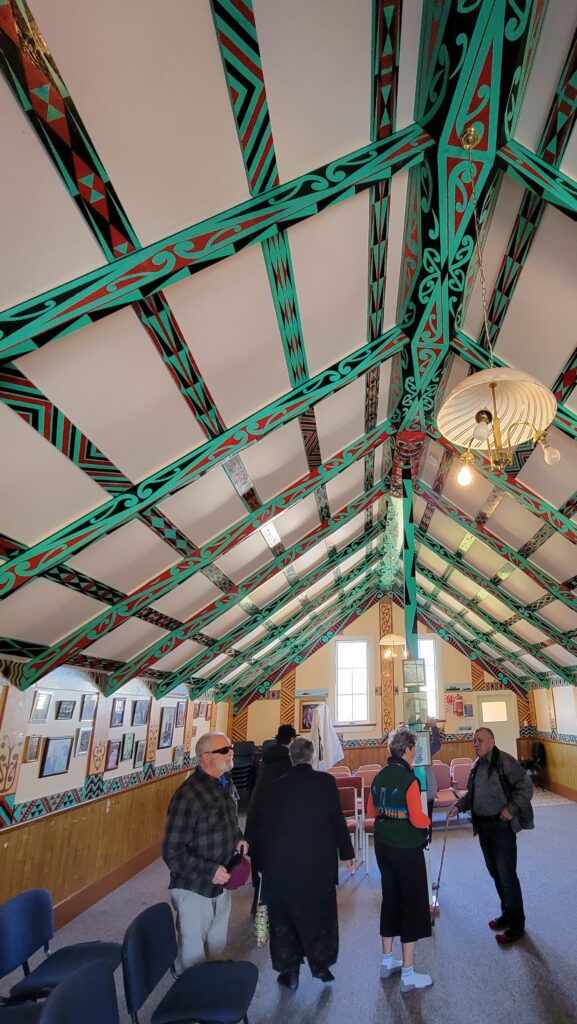
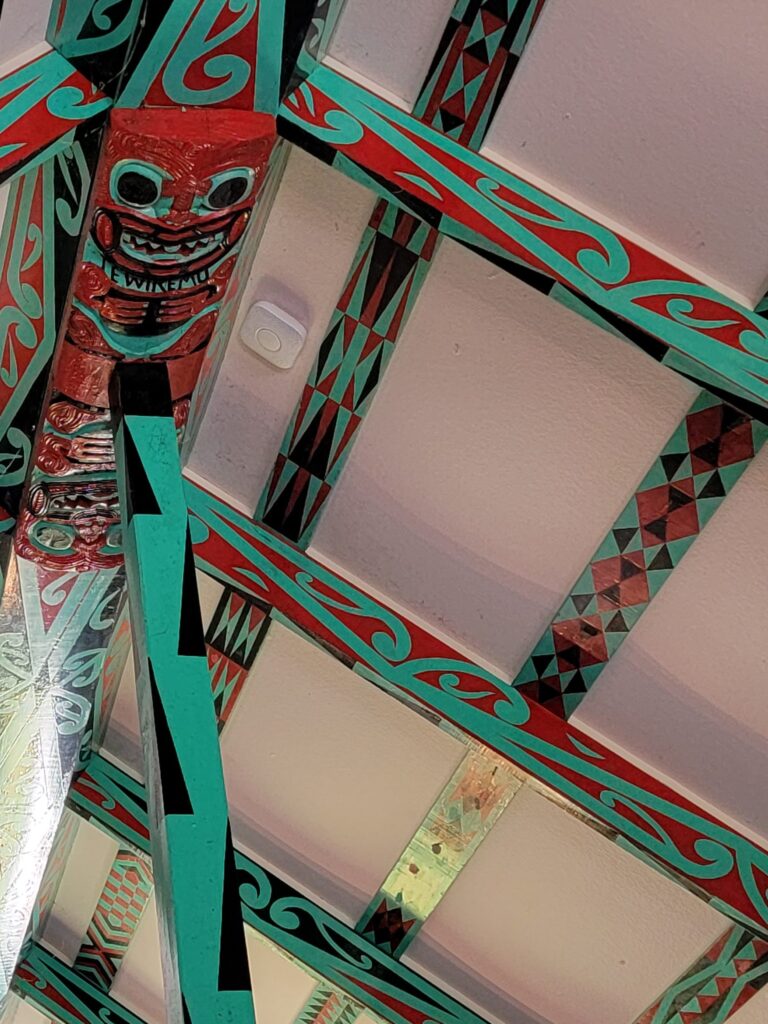
If a person dies in the community, they are kept out on the porch and then brought into the building by the window, because the door is for the living. People sit with the body and get up and share stories. After the third day, the body is brought to the cemetery, and the community has a huge meal to release it from the grieving. The photos on the wall of the Marae are those who have passed in this community.
Speaking of eels (weren’t we?), they have to migrate from the streams down to the ocean to spawn. Of course, the white folks put up a big hydroelectric dam without thinking of this, and they are now endangered from being chopped up in the turbines. This Iwi got an actual government grant to take boats out, gather the eels, take them up over the dam, and release them. (!) When talking about the eels coming back after spawning, the elder said that they “looked like little butterflies made of glass.” (!)



Next, on to Kohutapu Lodge, where we had a traditional hangi lunch. Our guide was very excited to tell us that they had been the Supreme Winner of the New Zealand Tourist Awards this past year – the first fully-owned Māori business in over 20 years.

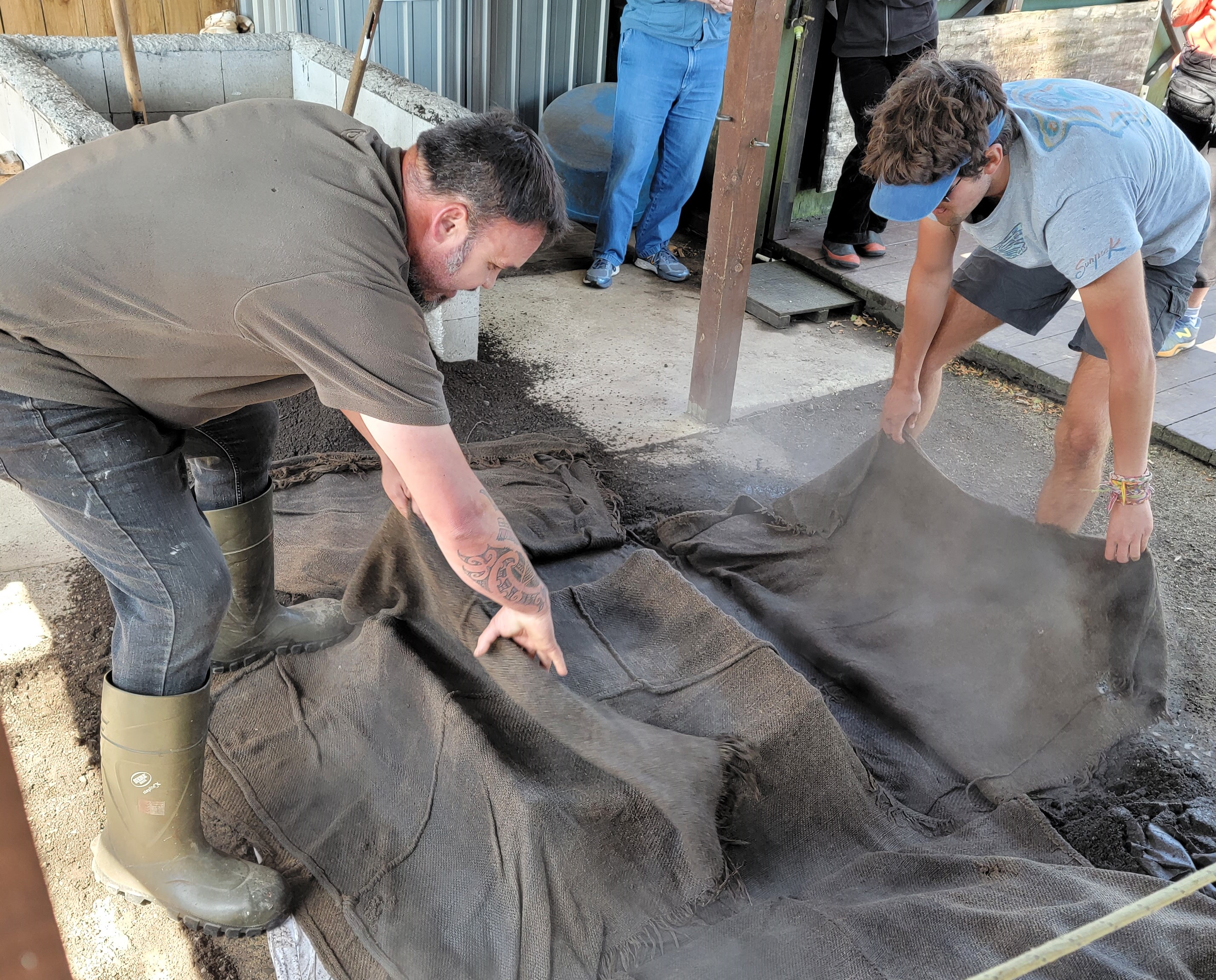
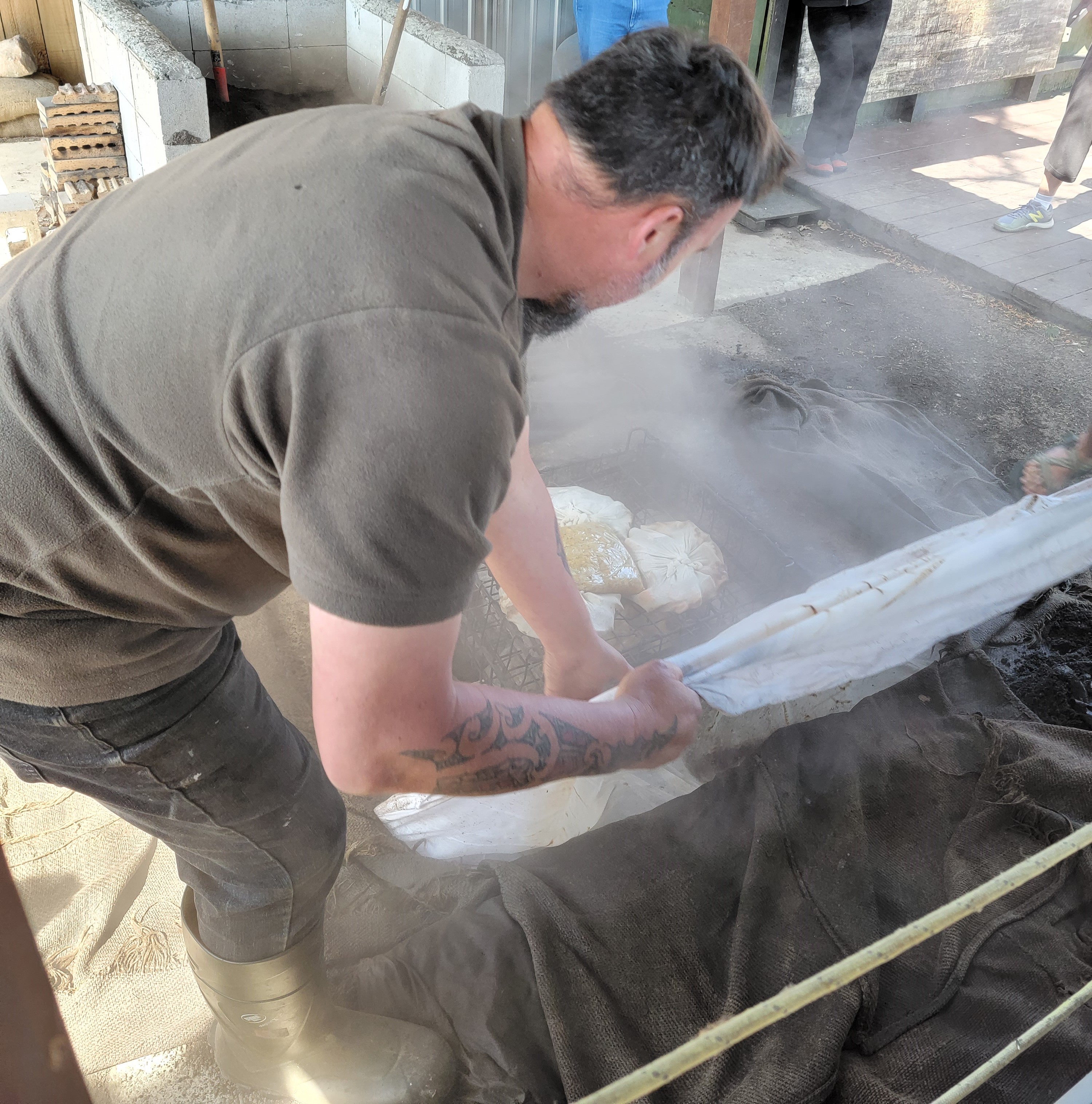



.While we were waiting for the hangi to be dug out, we wandered around the farm. They had a horse, a deer (venison is farmed in New Zealand), a goat, a black pot-belled-type pig, and then Porkchop, a big sow. We were told that if an animal is given a name, you can’t eat it. So Porkchop will not be one 😊
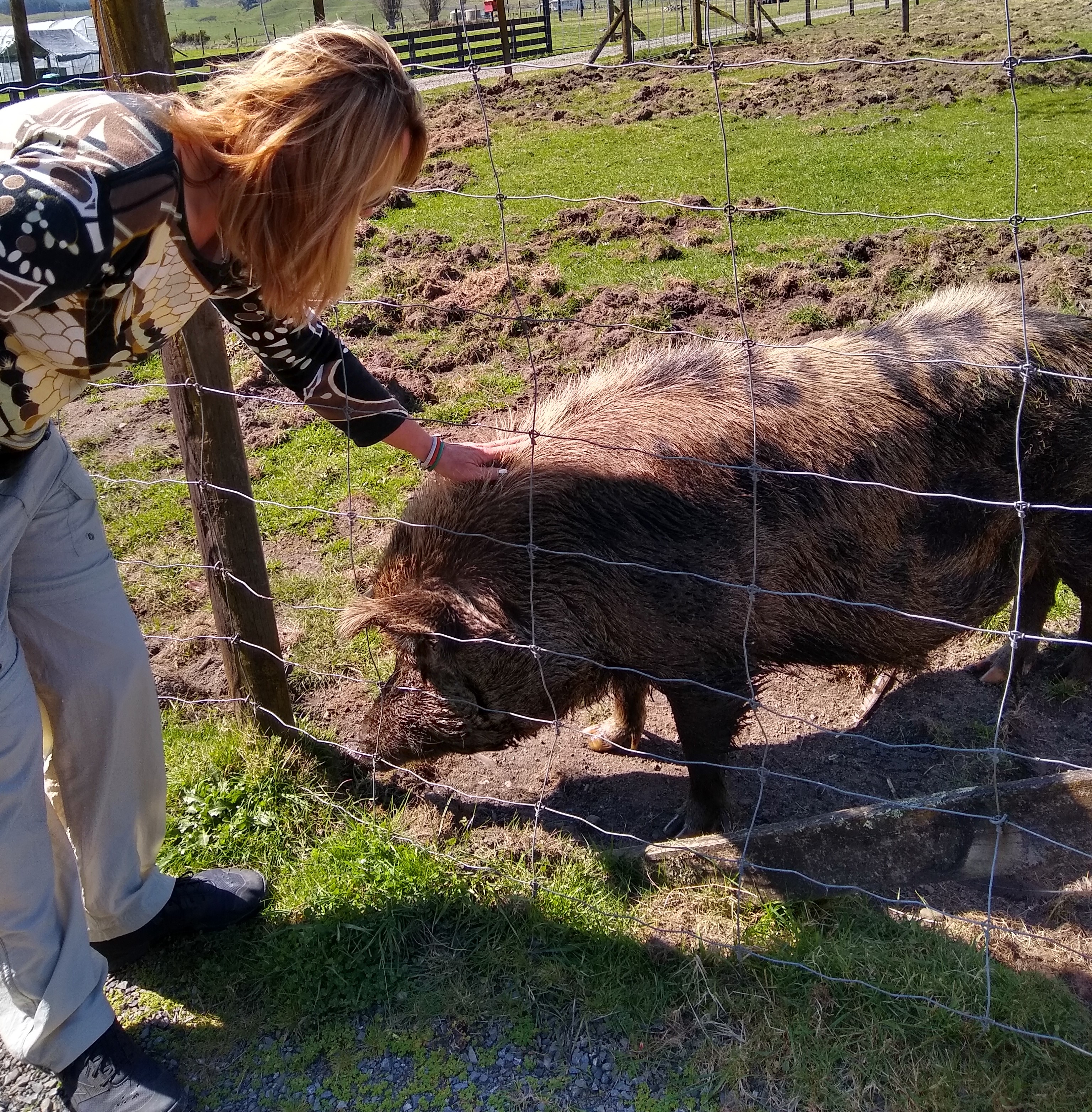
I love pigs (please, no bacon comments . . . ). I have a great picture from our Honeymoon of me chatting with a pig. I even have photos when I traveled up through Alaska after law school of me and a big pig. Well, Porkchop received a lot of attention from me. I started by scratching her back. She was so happy about it that she flopped down on her side and raised her head to me (a bit like Clementine!) so that I could scratch her big ears. I think she might have tried to get in my lap a la Clemmie if there hadn’t been a wire fence between us! Funnily enough the goat got very jealous of my attentions to Porkchop!



After the hangi was unearthed, we had a big buffet lunch. They had made fried bread (recipe below), and you were instructed that “their way” was to open it up and make a bit of a “Thanksgiving sandwich” from the smoked meat from the hangi (I took chicken), kumara (sweet potato), stuffing, and cranberry sauce! Nom Nom! We had hand-woven (believe from flax leaves?) “baskets” to put the lunch in.
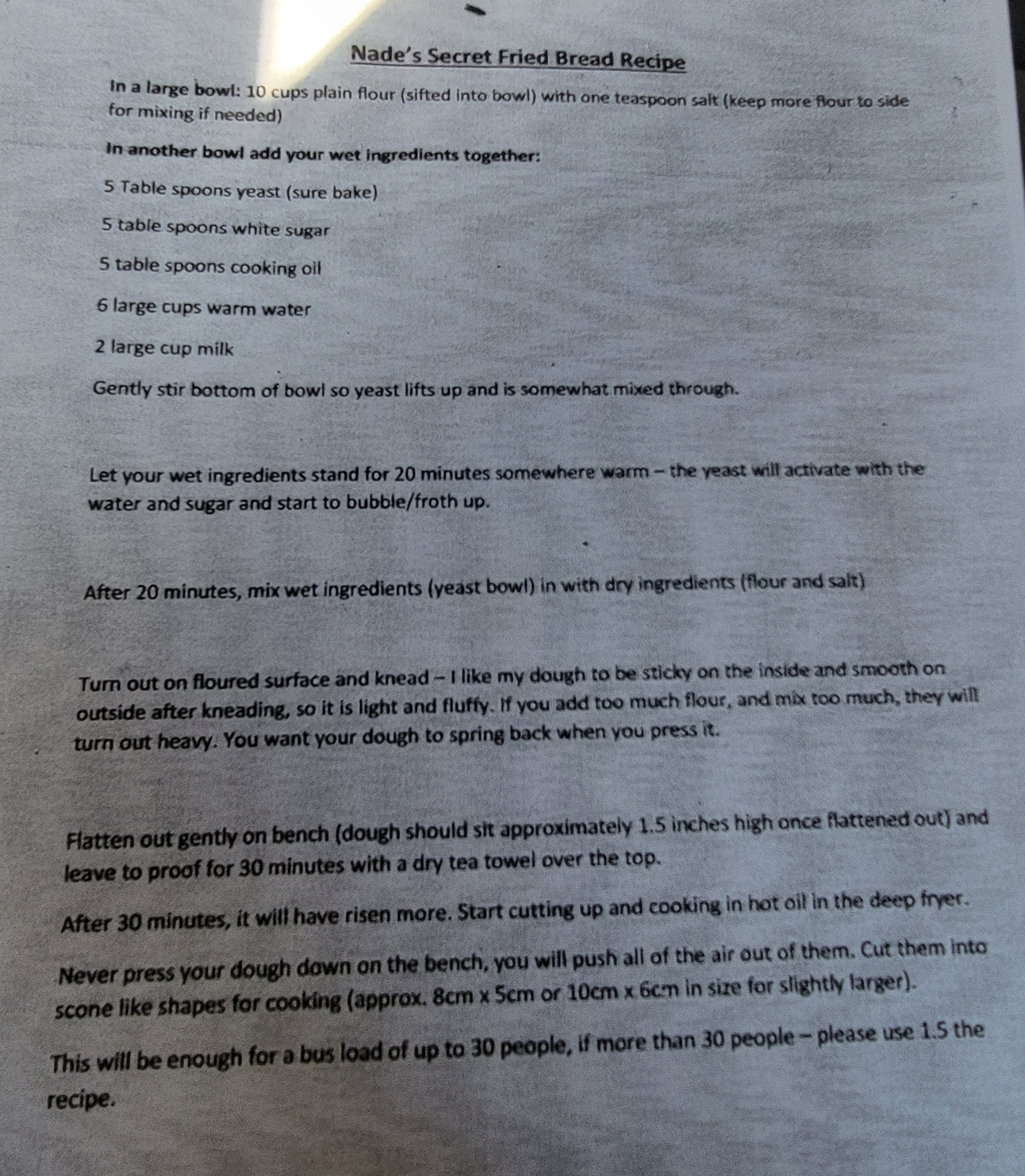
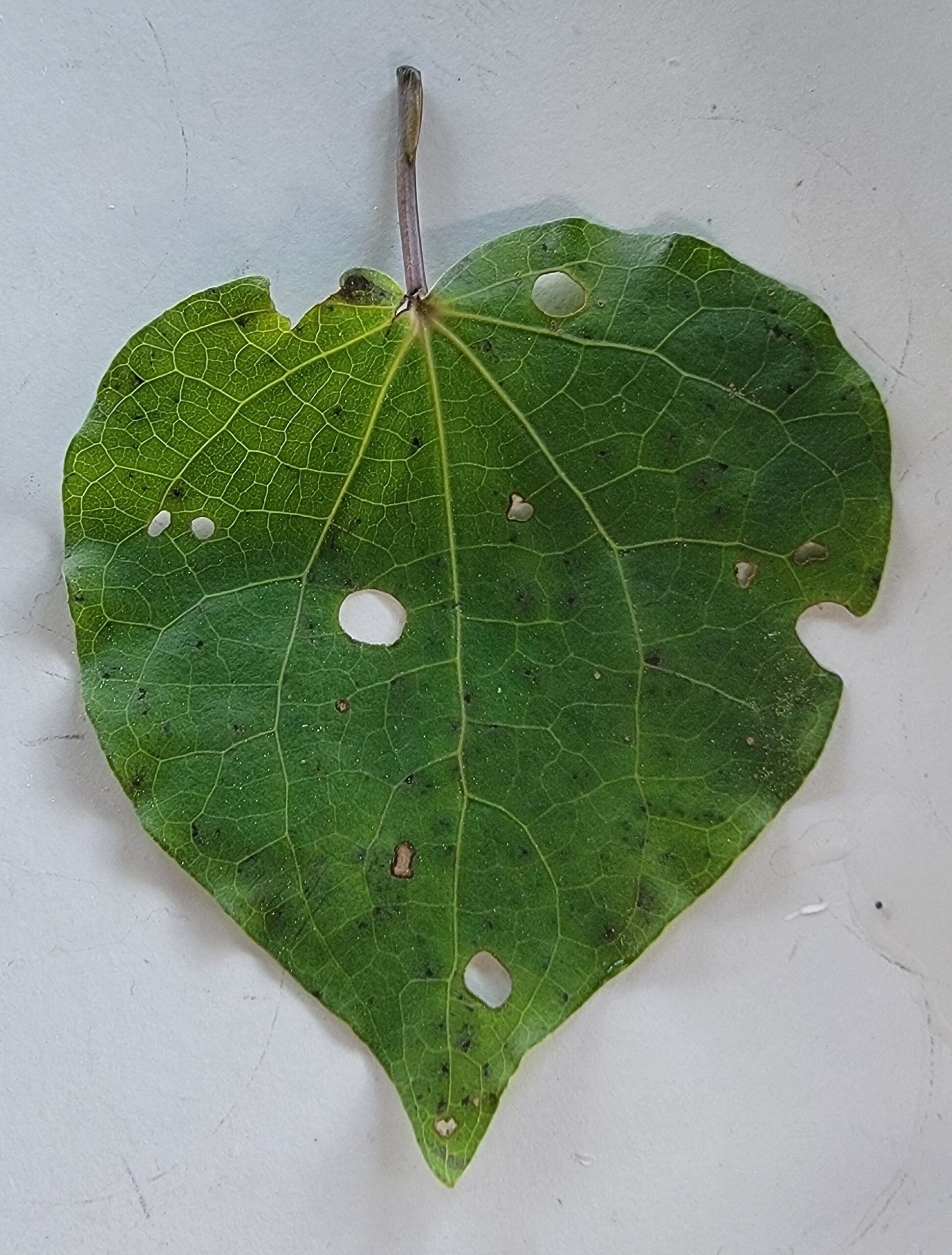
Afterwards, we had kawakawa tea, and learned about the kawakawa plant. You can see from the photo that it’s heart shaped. It’s good for your heart and veins. They make not only a tea but poultices, etc. When you pick the leaves you want the ones with the holes in them, as the “caterpillars tell you” that the leaf is ready to eat. It will have caterpillar slime on it, but “that’s good for you too.”
Finally, we learned how to do the haka. The only real difference between women doing the haka and men is that women don’t stick their tongues out because “they didn’t take part in the ritual cannibalism that this move represents.” They do the rest the same – bugged out eyes, “scary face,” etc.
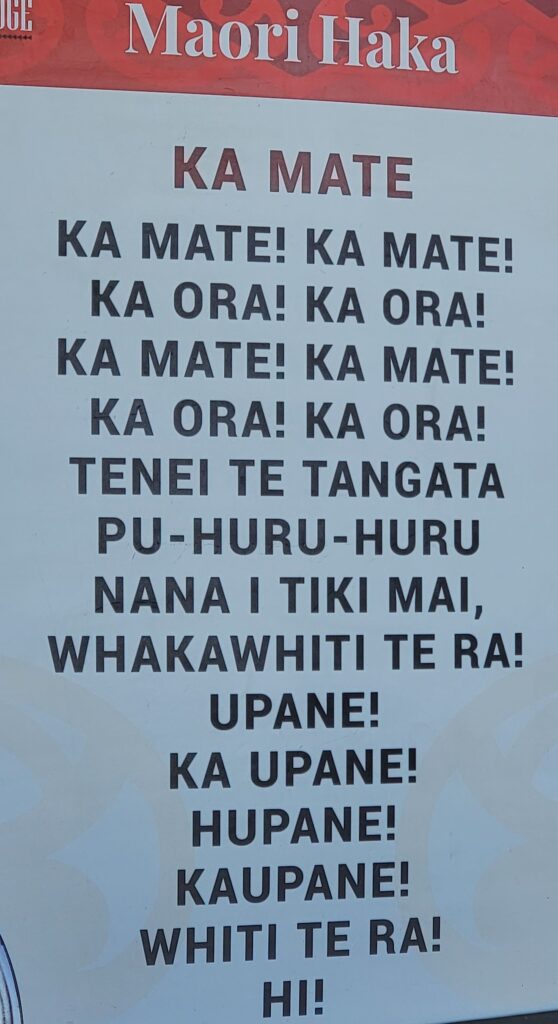
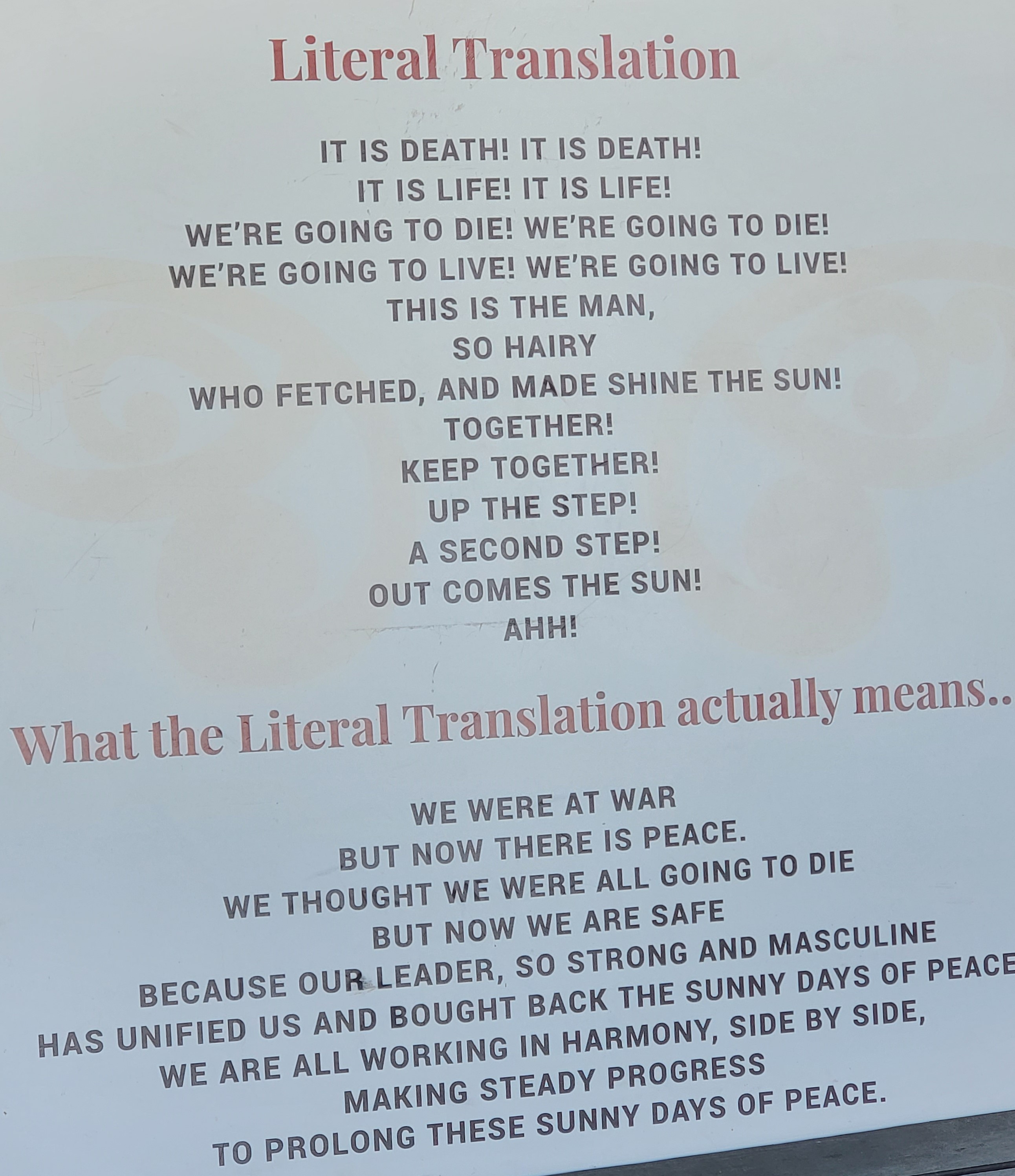
Here’s a video of the New Zealand Rugby Men’s Team doing the haka:
Here’s a woman’s one:
Our young guide bid us “Kia kite ano” (kia Kee-teh Ah-no)– till I see you again – and I was back to the hotel in time to head off with two of the other gals to Wai Ariki, the new spa in town.
Our Guide recommended the Wai Whakaora (Why Fa-ka-OR-ah) – “Restorative Journey.”
Take a look at the link above if you want to get an idea of what the two-hour experience is like. It was $110NZ, which is about $65 (less if you don’t want the robe, towel and slippers, but who wouldn’t?). The way that they describe it is a lot more romantic than I will here!
You are walked through with a Māori attendant before you go to put on your bathing suit. While you’re told about how much time to spend in each section, you guide your own journey. (In other words, there aren’t attendants to take you from place to place, though there are attendants around if you need anything.) The three of us from O.A.T. were Pam (who had a facial, and then just the outdoor pools), Betsy, and me. After being taken through, Betsy and I left Jan, put on our bathing suits, and off we went on our Journey!
First area: You go through this one at a time. It’s a short hallway that has water and light flowing from the ceiling, each for about 15 seconds. Warm, cool, hot (red lights), then COLD (turquoise lights)!
From here to the “Fire and Ice” area. You are to spend 10 minutes (or, as Betsy figured out, four of the relaxing songs that played in each area) in each hot/dry sauna, doing cold/wet in between. The first sauna was a “bio” sauna – not very hot, comfortable. Then, we walked slowly through a horseshoe of freezing cold water up to about knee height (there was one at Sanoviv like this). Next was a hay sauna. Yes, hay was hanging on the walls in burlap sacks! I stepped in and actually blocked the door and immediately said to Betsy “You don’t have hay fever, do you?” She didn’t, luckily! That was my favorite. The sweet smell of hay in the dry/hot sauna was pretty awesome. The last sauna was a very warm “wet” sauna (in other words, you put water on the rocks and it made a bit of a steam in the room).
But what was in between?
The “Frigidarium” of course! Betsy said that she didn’t want to do it but I egged her on and I went first. It was a glass box with a lavender light inside, with a big pile of SnoCone-type shaved ice on the left. I turned my back to her and said “Just pile it on.” EEEEP it was cold! We were really laughing. (What a bonding experience 😊) Then I had her turn around and packed the ice on her back, back of her arms, legs. After that, there were big cedar buckets on the right wall, both with a chain hanging down. You pull the chain, and ice water comes crashing down on your head. Betsy looked at it with trepidation, so I said “All right then, let’s go, on the count of three . . . “ and I counted 1…2….3, but waited a split second to be sure she was really going to pull the chain, because if she didn’t, I wasn’t! But she did – so I did. We both screamed!
After the last sauna, we headed outside, where we met Jan coming from her facial. There are a number of large pools, looking out on Lake Rotorua. In the first one, you lie and float above benches affixed to the bottom. This was very clever, because it meant you could float, but if you stayed above your bench, you didn’t float into anyone else. It was 32C (90F). The next pool was like a square with another square inside. The “outside” of the square was very very hot – definitely made your skin red. I’d say it was something like 44C. After you walked “around” that outside of the square (which you did very slowly as every movement moved the deeply hot water against your legs/body), you walked down into the middle pool, which was a very cold deep bath. Betsy went in first, and said that she had “broken a rime of ice” to get in. Whew it was cold!
After this was a herbal pool (with kawakawa as one of the herbs!), then a pool with bubbler chaises under the water to lie on, and waterfall-like fixtures that you could sit under and let it gush down on your head and shoulders.
From there it was to the mud. Betsy and I convinced Jan to come with. She’d done a “full mud bath” in Calistoga and hated it, but this was much more civilized (laugh!) You lay down on a warm black tiled chaise and got a metal bowl with warm Rotorua mud in it. You put it on yourself, then lay down on the chaise until it dried (about 10 mins – again, about 4 songs). Then to a steam room that was huge/like a Turkish bath with a dais in the middle and water wands on the walls to wash off the mud, then another shower just in case you missed some mud morsel . . . then we were through our “Journey.”
I called the Uber, and though Betsy said that she’d walk the couple streets to the evening dinner (Jan and I were headed back to the hotel), I had her come with us. During the pandemic the country was shut tight and Lufthansa, etc. were called in to take anyone not a resident back to their home countries. Of course, that meant that there was no tourism, jobs…and a lot of homeless. As Rotorua has an area that used to be called “Roto-Vegas” because its a strip of motels (motel = “room with kitchen”), the government put up the North Island’s homeless there. Unfortunately, as the homeless were not paying anything for the accommodations, they destroyed their hotels, and there is still a lot of drugs, theft, and just general unsafety, particularly at night. There are still seventeen motels with the unhoused in them – many near our hotel.
Our hotel here is a bit of a dowager. Though we have a fantastic room, the room was freezing! (We discovered later than top windows were open in a few of the rooms) When we called down to have the heat increased, we were offered space heaters and extra blankets (we took the latter).
After downloading the “Journey” experience to Lynn – off to bed!
NOTE: Here you can pick Uber “Green” or “regular” Uber. They have been the same price each time I’ve called one (out and back to the boathouse in Auckland, and out and back to the spa here). When I went to call the Uber, I received a message that “since I had used Uber Green three times,” if I continued to use it, I would now receive a 20% price discount. Wow! Again – the price was the same as the “regular” Uber, so I thought “Why not?” Glad I did!
If you want $100 off, call OAT at 1-800-955-1925 and request a catalog, tell them you were referred by Sandy Shepard, customer number 3087257, and get $100 off your first trip!

